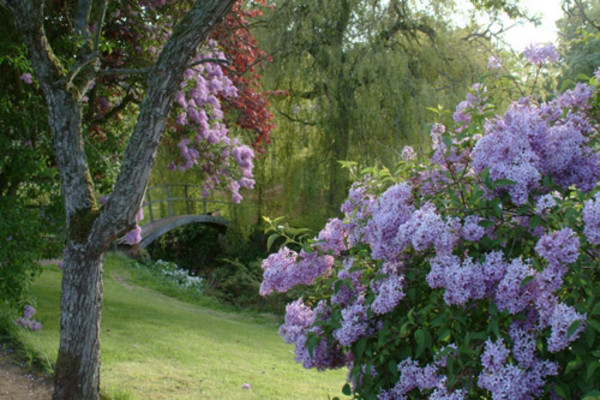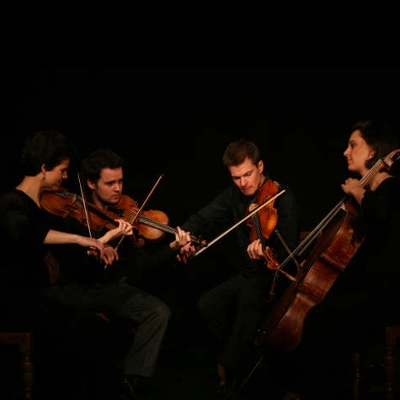East Neuk Festival, Cambo Estate/Crail Church | reviews, news & interviews
East Neuk Festival, Cambo Estate/Crail Church
East Neuk Festival, Cambo Estate/Crail Church
This Scottish festival is small but perfectly-formed

Scotland’s East Neuk is a little like Hardy’s Wessex – less a geographical specific and more an idea, a resonance. Tucked up into the crook of the Firth of Forth, directly below St Andrews, the region encompasses the tiny coastal towns of Crail, Pittenweem, Anstruther and St Monans, where stern stone cottages and still sterner churches have done battle with the elements since at least the 9th century.
Founded in 2005, the festival has always maintained an eclectic mixture of musics, but contemporary works have remained a constant. Last weekend however saw East Neuk’s most ambitious project to date. Inspired by Adams’ home landscape of Alaska and conceived for outdoor performance, John Luther Adams’ Inuksuit is more sound installation than a piece in the conventional sense. Any work for which the use of “GPS units”, “topographic maps” and “tents” is potentially advised leaves little doubt of its progressive credentials. In its Scottish iteration however no tents were required, with the performance framed in the glorious walled garden (pictured below right) of East Neuk’s Cambo Estate.
 Thirty percussionists sprouted from borders, stood framed in willow branches and were dispersed across lawns. The audience were encouraged to wander, chasing sounds as we wished, or simply sitting down and letting them fan out around us. In practice most of us did both, lulled into stillness by the work’s contemplative outer sections, but stirred into movement by its central animation – fulfilling Adams’ own creative vision of spatial and sonic blurring.
Thirty percussionists sprouted from borders, stood framed in willow branches and were dispersed across lawns. The audience were encouraged to wander, chasing sounds as we wished, or simply sitting down and letting them fan out around us. In practice most of us did both, lulled into stillness by the work’s contemplative outer sections, but stirred into movement by its central animation – fulfilling Adams’ own creative vision of spatial and sonic blurring.
Enacting “a single breath”, the work grows out of husky, unpitched breathings, the gentlest of blowings into man-made tubes that duetted here with the gulps of the stream, before growing into percussive violence as sirens and bullroarers give voice. It’s confrontingly primal, with instruments often establishing tense duets and trios, batting sounds to and fro across the space in combative style. But for all the score’s inherent freedoms, there’s nothing anarchic about Inuksuit. Perhaps this was the careful direction of Bang On A Can’s Steve Schick (who has a long and intimate association with the work), but the generous abstraction of the concept invites listeners to fill it with narrative, while keeping the musical structure simple enough to act as scaffolding to any number of stories.
 At the other musical extreme from Adams’ experimentalism, East Neuk also offers a programme of core chamber works. One ensemble who have been regular visitors to the festival (and will return again next year) are the Elias Quartet (pictured left), whose first of two concerts paired Schumann’s Quartet No. 1 Op. 41 with Beethoven’s No. 13 in B-flat major, Op. 130.
At the other musical extreme from Adams’ experimentalism, East Neuk also offers a programme of core chamber works. One ensemble who have been regular visitors to the festival (and will return again next year) are the Elias Quartet (pictured left), whose first of two concerts paired Schumann’s Quartet No. 1 Op. 41 with Beethoven’s No. 13 in B-flat major, Op. 130.
Former Radio 3 New Generation Artists, the quartet have been quietly establishing themselves among the UK’s leading young ensembles over the past few years and are currently working on an extended Beethoven project. But before the meat of the Beethoven with its mighty Grosse Fugure finale, we opened with Webern’s emotive miniature Langsamer satz. The quartet’s blend lent burnished unanimity to the opening, never over-complicating the musical sincerity. Yet for all their accomplished simplicity, doing less so elegantly where more might have been the easy option, they didn’t quite find the strength to force the moment to its crisis, to follow Webern into his youthful extremity of emotion.
Any doubts though found little foothold in the Beethoven – calibrated minutely to allow for the weightier finale, building from the throwaway wit and ebullience of the Presto into a measured Andante before stripping all right back (our resistance too) for the Cavatina, flaying us bare in preparation for the fugue. Here, only a slightly underweighted viola, blurred a serious climax, showcasing the quartet’s technical abilities but also their expressive control, never allowing the beast to dominate them and their interpretative choices.
rating
Explore topics
Share this article
The future of Arts Journalism
You can stop theartsdesk.com closing!
We urgently need financing to survive. Our fundraising drive has thus far raised £49,000 but we need to reach £100,000 or we will be forced to close. Please contribute here: https://gofund.me/c3f6033d
And if you can forward this information to anyone who might assist, we’d be grateful.

Subscribe to theartsdesk.com
Thank you for continuing to read our work on theartsdesk.com. For unlimited access to every article in its entirety, including our archive of more than 15,000 pieces, we're asking for £5 per month or £40 per year. We feel it's a very good deal, and hope you do too.
To take a subscription now simply click here.
And if you're looking for that extra gift for a friend or family member, why not treat them to a theartsdesk.com gift subscription?
more Classical music
 First Person: Manchester Camerata's Head of Artistic Planning Clara Marshall Cawley on questioning the status quo
Five days of free events with all sorts of audiences around Manchester starts tomorrow
First Person: Manchester Camerata's Head of Artistic Planning Clara Marshall Cawley on questioning the status quo
Five days of free events with all sorts of audiences around Manchester starts tomorrow
 Goldscheider, Brother Tree Sound, Kings Place review - music of hope from a young composer
Unusual combination of horn, strings and electronics makes for some intriguing listening
Goldscheider, Brother Tree Sound, Kings Place review - music of hope from a young composer
Unusual combination of horn, strings and electronics makes for some intriguing listening
 theartsdesk Q&A: composer Donghoon Shin on his new concerto for pianist Seong-Jin Cho
Classical music makes its debut at London's K-Music Festival
theartsdesk Q&A: composer Donghoon Shin on his new concerto for pianist Seong-Jin Cho
Classical music makes its debut at London's K-Music Festival
 Helleur-Simcock, Hallé, Wong, Bridgewater Hall, Manchester review - moving lyricism in Elgar’s concerto
Season opener brings lyrical beauty, crisp confidence and a proper Romantic wallow
Helleur-Simcock, Hallé, Wong, Bridgewater Hall, Manchester review - moving lyricism in Elgar’s concerto
Season opener brings lyrical beauty, crisp confidence and a proper Romantic wallow
 Kohout, Spence, Braun, Manchester Camerata, Huth, RNCM, Manchester review - joy, insight, imagination and unanimity
Celebration of the past with stars of the future at the Royal Northern College
Kohout, Spence, Braun, Manchester Camerata, Huth, RNCM, Manchester review - joy, insight, imagination and unanimity
Celebration of the past with stars of the future at the Royal Northern College
 Jansen, LSO, Pappano, Barbican review - profound and bracing emotional workouts
Great soloist, conductor and orchestra take Britten and Shostakovich to the edge
Jansen, LSO, Pappano, Barbican review - profound and bracing emotional workouts
Great soloist, conductor and orchestra take Britten and Shostakovich to the edge
 Jakub Hrůša and Friends in Concert, Royal Opera review - fleshcreep in two uneven halves
Bartók kept short, and a sprawling Dvořák choral ballad done as well as it could be
Jakub Hrůša and Friends in Concert, Royal Opera review - fleshcreep in two uneven halves
Bartók kept short, and a sprawling Dvořák choral ballad done as well as it could be
 Hadelich, BBC Philharmonic, Storgårds, Bridgewater Hall, Manchester review - youth, fate and pain
Prokofiev in the hands of a fine violinist has surely never sounded better
Hadelich, BBC Philharmonic, Storgårds, Bridgewater Hall, Manchester review - youth, fate and pain
Prokofiev in the hands of a fine violinist has surely never sounded better
 Monteverdi Choir, ORR, Heras-Casado, St Martin-in-the-Fields review - flames of joy and sorrow
First-rate soloists, choir and orchestra unite in a blazing Mozart Requiem
Monteverdi Choir, ORR, Heras-Casado, St Martin-in-the-Fields review - flames of joy and sorrow
First-rate soloists, choir and orchestra unite in a blazing Mozart Requiem
 Cho, LSO, Pappano, Barbican review - finely-focused stormy weather
Chameleonic Seong-Jin Cho is a match for the fine-tuning of the LSO’s Chief Conductor
Cho, LSO, Pappano, Barbican review - finely-focused stormy weather
Chameleonic Seong-Jin Cho is a match for the fine-tuning of the LSO’s Chief Conductor
 Classical CDs: Shrouds, silhouettes and superstition
Cello concertos, choral collections and a stunning tribute to a contemporary giant
Classical CDs: Shrouds, silhouettes and superstition
Cello concertos, choral collections and a stunning tribute to a contemporary giant
 Appl, Levickis, Wigmore Hall review - fun to the fore in cabaret and show songs
A relaxed evening of light-hearted fare, with the accordion offering unusual colours
Appl, Levickis, Wigmore Hall review - fun to the fore in cabaret and show songs
A relaxed evening of light-hearted fare, with the accordion offering unusual colours

Add comment